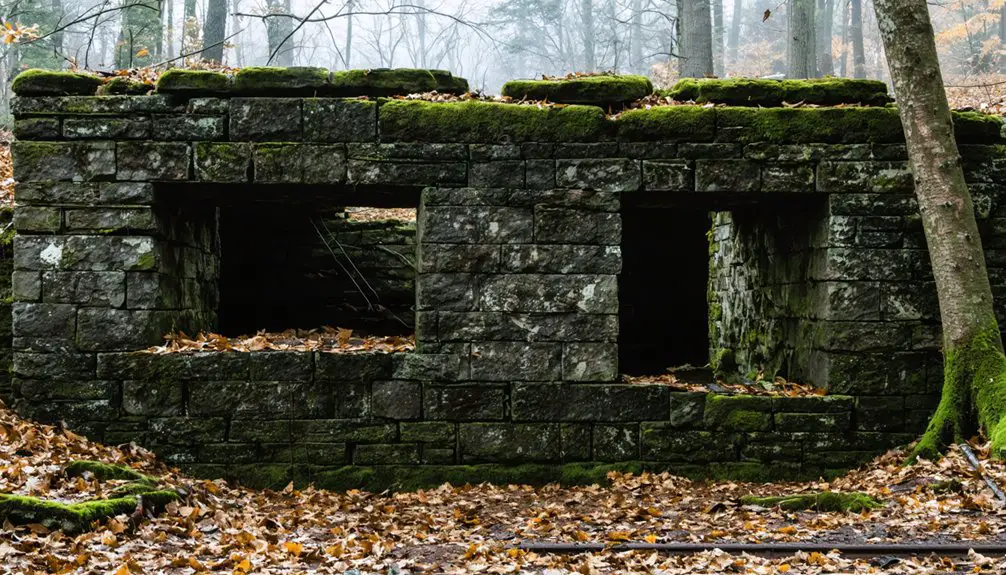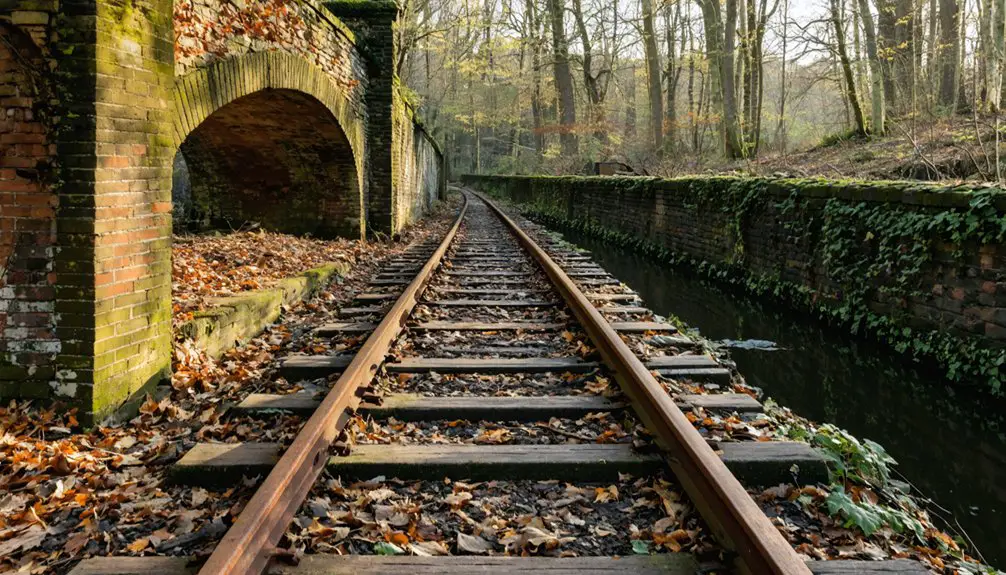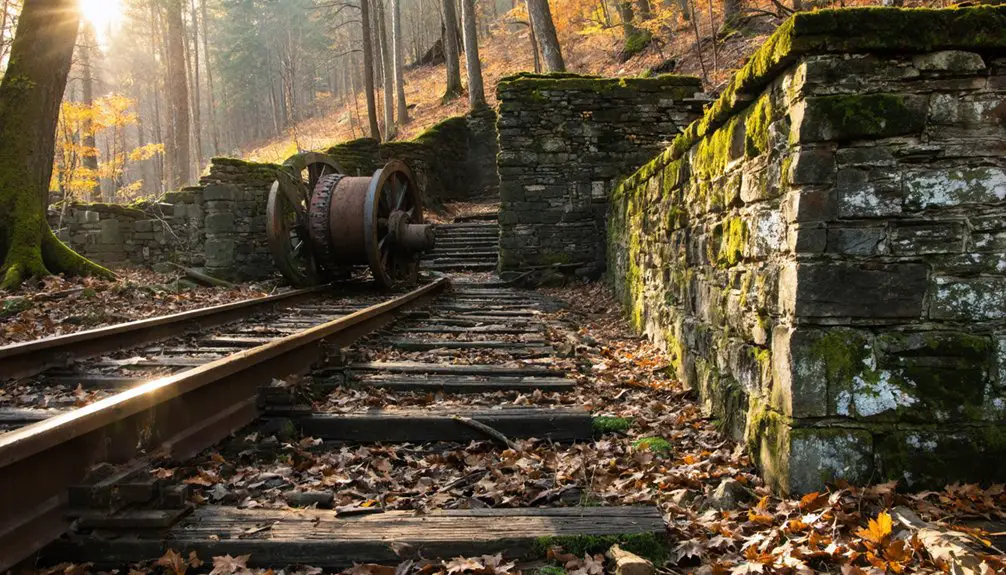You’ll find Rausch Gap nestled in Pennsylvania’s Stony Valley, where Dr. Benjamin Kugler established the first coal mine in 1823. This once-bustling industrial hub grew to house 1,000 residents by the 1850s, with the Dauphin & Susquehanna Railroad fueling its expansion. Poor coal quality and the 1872 relocation of railroad operations to Pine Grove led to its abandonment by 1910. Today, stone foundations and a historic cemetery hint at deeper stories beneath the reclaimed wilderness.
Key Takeaways
- Rausch Gap was a thriving 19th-century coal mining town in Pennsylvania that supported nearly 1,000 residents before becoming completely abandoned by 1910.
- The town’s decline began with the 1872 relocation of railroad headquarters to Pine Grove, coupled with inferior coal quality compared to other mines.
- Today, only scattered stone foundations, mining remnants, and a historic cemetery remain visible among the reclaimed natural vegetation.
- The former railroad bed through Rausch Gap has been converted into part of the modern Appalachian Trail system.
- The town originated in 1823 with Dr. Benjamin Kugler’s coal mine establishment and grew rapidly due to railroad development in the 1850s.
The Birth of a Mining Town (1823-1828)
While Pennsylvania’s Anthracite Region was rapidly expanding in the 1820s, Dr. Benjamin Kugler established the area’s first coal mine on Sharp Mountain in 1823.
As a Philadelphia industrialist and patent holder for coal-to-gas conversion technology, Kugler’s industrial innovation helped shape Lebanon County’s early development.
The region saw rapid growth as small mining communities sprang up to house the workers.
By 1854, this area would become home to Roush Gap Cemetery, serving a thriving coal mining community of nearly 1,000 residents.
Coal and Railroad: Building an Industrial Hub
When Dr. Benjamin Kugler opened the first coal mine near Rausch Gap in 1823, you’d never have guessed this remote Pennsylvania site would transform into a bustling industrial center.
The construction of the Dauphin & Susquehanna Railroad between 1850-1851 turned the once-quiet mining operation into a thriving hub, spurring the development of two dozen houses and establishing essential coal transport routes to Philadelphia and Harrisburg.
Yet this prosperity wouldn’t last – despite shipping over 1,150,300 tons of coal by 1928, the town’s fate was sealed when railroad headquarters relocated to Pine Grove in 1872, marking the beginning of Rausch Gap’s decline. The early miners earned $1.00 per day while local boys working in the mines made half that amount. The town was eventually completely abandoned by 1910 as the coal mines were depleted and employment opportunities vanished.
Mining Operations Begin 1823
In 1823, Dr. Benjamin Kugler launched the first coal mining operation in what would become Rausch Gap, establishing a vital foothold in Pennsylvania’s lower Anthracite Region.
You’ll find his pioneering work along the northern slope of Sharp Mountain in Cold Spring Township, Lebanon County, where his industrial innovations helped shape early mining techniques in the region.
Railroad Powers Town Growth
After the Pennsylvania Legislature authorized new rail construction in 1838, Rausch Gap emerged as an essential transportation hub linking the region’s coal mines to broader markets.
You’ll find the railroad’s impact transformed this small mining settlement into a bustling industrial center by 1851, with nearly two dozen houses and crucial support facilities. The reliable industrial transportation helped establish new towns and urban centers throughout the region.
The town’s economic growth accelerated as engineers Edward Miller and Charles R. Paxton oversaw construction of the rail line to Dauphin in 1850.
You can trace how Rausch Gap’s strategic importance grew with its company headquarters, machine shops, and coal breaker becoming central to regional operations. The Dauphin and Susquehanna began mining operations in several locations around the town.
The 1853 stone arch bridge showcased the era’s engineering prowess, while the completed 51-mile line to Auburn by 1854 freed local coal transport from the limitations of water navigation.
Industry’s Short-Lived Success
Though Rausch Gap‘s early mining operations began promisingly in 1823 along Sharp Mountain’s northern slope, you’ll find the town’s industrial success proved remarkably brief.
Despite the community’s resilience in establishing nearly two dozen homes and developing essential railway connections by 1851, the coal heritage of Rausch Gap faced mounting challenges. The inferior quality of local anthracite compared to other Pennsylvania sources undermined long-term sustainability.
You can trace the town’s decline to 1872 when railroad headquarters relocated to Pine Grove, triggering an exodus of workers and families. By the early 1900s, mining operations had largely ceased, with production shifting to nearby operations like Keffer’s Tunnel.
The once-bustling mining settlement couldn’t overcome the combined pressures of poor coal quality and changing transportation routes.
Life in Rausch Gap’s Golden Years
During its mid-19th century peak, Rausch Gap bustled with nearly 1,000 residents who’d built their lives around the town’s thriving coal and railroad industries.
You’d find about two dozen houses made of board and stone, where miners and railroad workers returned after long days of labor. Daily routines revolved around the harsh demands of coal extraction and rail operations in this remote valley settlement.
Community events brought together the close-knit population, who relied on local springs for their water needs. While specific records of social gatherings are scarce, you can imagine the camaraderie among workers and families who shared the challenges of life in Saint Anthony’s Wilderness.
The town cemetery, where many residents were laid to rest, stands as a tribute to the bonds forged in this rugged mountain outpost.
The Town’s Infrastructure and Development

When railroad construction began in 1850, Rausch Gap’s transformation from wilderness to industrial hub accelerated rapidly.
Within a year, you’d have seen two dozen board and stone houses springing up alongside the newly laid tracks, which would eventually stretch 51 miles to Auburn. The town’s infrastructure centered on coal mining operations, complete with a coal yard and innovative water management systems.
Today, you’ll find infrastructure remnants scattered throughout the former town site – stone foundations, an abandoned well, and partially intact dams that once regulated water flow. In its peak years between 1828 and 1910, the town supported over 1,000 residents.
The industrial legacy lives on through diversion wells that were designed to treat acidic mine water. While the railroad tracks were removed by 1945, you can now explore these historic ruins via the Stony Valley Rail Trail, which follows the old railroad bed.
Forces Behind the Decline
As railroad headquarters relocated from Rausch Gap to Pine Grove in 1872, the town’s fate took a devastating turn.
You’ll find that multiple forces converged to trigger a rapid economic decline, leaving the once-bustling mining town nearly abandoned by 1900.
Three key factors sealed Rausch Gap’s destiny:
- The headquarters move stripped away essential machine shops and company offices, triggering immediate job losses.
- Local coal’s inferior quality couldn’t sustain long-term mining operations or attract industrial interest.
- The Civil War’s disruption of economic activities, followed by post-war restructuring, accelerated the town’s downfall.
Population migration became inevitable as residents sought opportunities elsewhere. The abandoned mine drainage contaminated Roush Creek’s water, making the area less habitable.
The town’s strategic importance diminished when railroad extensions favored other locations, and by 1945, even the railroad tracks disappeared from Rausch Gap’s landscape.
The Final Days of Abandonment

Following the relocation of railroad headquarters in 1872, Rausch Gap experienced its terminal decline through the early 1900s.
You’d have witnessed the final community slowly dissolve as families sought work elsewhere, leaving behind their homes and livelihoods.
The economic decline accelerated as coal mines depleted and railroad operations shifted to more prosperous towns.
Natural Reclamation and Present Ruins
If you visit Rausch Gap today, you’ll find native hardwoods, vines, and ferns have reclaimed most of the abandoned town, though scattered stone foundations and coal mining remnants still peek through the Pennsylvania forest floor.
The former railroad bed, converted to part of the Appalachian Trail system, guides you past these weathered ruins of houses and industrial structures that once formed a bustling mining community.
Among the most enduring features, the 19th-century cemetery remains partially maintained, its weathered gravestones offering silent testimony to the town’s former residents while nature steadily encroaches on its boundaries.
Nature’s Persistent Takeover
While the mining town of Rausch Gap once bustled with industrial activity, nature has steadily reclaimed the abandoned settlement over decades of neglect.
You’ll find dense vegetation encroachment as native oaks and maples overtake former residential sites, while moss and lichen blanket the remaining stone foundations. Wildlife resurgence is evident as deer, birds, and small mammals now inhabit areas where miners once worked.
The site’s transformation continues through:
- Seasonal cycles of freeze-thaw that gradually break down remaining stonework
- Springs and watersheds that have returned to their natural courses, supporting diverse ecosystems
- Accumulating leaf litter and organic matter that steadily bury the ruins beneath new topsoil
Today, you’ll need trail markers to locate what remains of this once-thriving community beneath nature’s persistent advance.
Hidden Foundations Still Stand
Despite decades of abandonment, Rausch Gap’s structural legacy persists through its scattered stone foundations and cellar holes, offering glimpses into the town’s 19th-century layout.
You’ll discover hidden history in the flat stone platforms that once supported farm buildings along the creeks, while railroad-related architectural remnants, including an engine repair shed foundation, line the converted rail trail.
Near the Appalachian Trail shelter, you’ll find an abandoned well and flowing springs that once supplied the townspeople with water. Remnants of orange drainage water from historic mining operations still stain the local waterways.
The mix of stone foundations reveals the town’s diverse past, from board-and-stone houses with underground cellars to industrial structures that supported the coal mining operations.
These durable ruins, documented through archaeological digs in the 1970s, stand as silent witnesses to Rausch Gap’s bustling era. The nearby cemetery remains as one of the most well-preserved features of this once-thriving coal mining community.
Cemetery Withstands Time’s Test
Among Rausch Gap’s enduring landmarks, the town cemetery stands as its most resilient remnant, withstanding over 150 years of natural reclamation.
You’ll find this historic site, known as the only “white cemetery” in Stony Valley, surrounded by Pennsylvania’s native vegetation and weathered headstones that tell tales of the town’s final residents.
The cemetery’s significance extends beyond its physical presence, revealing:
- 19th-century burial customs and racial segregation patterns
- Demographic insights into the mining and railroad era
- Cultural heritage preserved through grave markers and stonework
While wooden structures have long vanished, you can still trace the cemetery’s boundaries along the Appalachian Trail.
Nature’s slow reclamation hasn’t erased this sacred ground, where weathered stones continue sharing stories of Rausch Gap’s bygone community.
Exploring the Ghost Town Today
Today, visitors who venture to Rausch Gap in Pennsylvania’s State Game Lands #211 will find only stone foundations and a small cemetery marking what was once a bustling railroad town.
Where a thriving railroad town once stood, only scattered stone ruins and a lonely cemetery remain in Rausch Gap’s wilderness.
Your ghost town exploration requires a 3.5-mile hike along marked trails, as the site isn’t accessible by vehicle. You’ll discover remnants of the past scattered throughout the wilderness, which has steadily reclaimed the former settlement.
The hiking trails, including a section of the Appalachian Trail, lead you through rugged terrain to various archaeological points of interest.
You’ll find a shelter maintained for through-hikers, complete with spring water and basic facilities. While exploring, you can trace the old railroad bed, now converted to a recreational trail, and examine the stone foundations that hint at the town’s former layout.
Legacy in Pennsylvania’s Mining History

When Dr. Benjamin Kugler opened his coal mine in 1823 near Sharp Mountain, he set in motion a legacy that would shape Pennsylvania’s mining history.
You’ll find Rausch Gap’s influence embedded in the region’s social dynamics and economic impact through:
- Innovation in mining technology, including Kugler’s pioneering work in converting coal to natural gas
- Transportation development with a 51-mile railroad network that transformed coal distribution to major markets like Philadelphia
- Community establishment patterns that exemplified the boom-and-bust cycle typical of Pennsylvania’s coal towns
Frequently Asked Questions
Were There Any Major Accidents or Disasters in Rausch Gap’s Mining Operations?
You won’t find documented major accidents or disasters in mining safety records. While accident reports detail numerous tragedies in nearby Schuylkill County mines, no significant incidents were recorded at Rausch Gap’s operations.
What Happened to the Residents’ Belongings When They Abandoned Their Homes?
You’d find that residents took their valuable possessions but left heavy, bulky items behind. Many abandoned possessions deteriorated over time, while others became lost memories buried beneath nature’s reclamation.
Are There Any Documented Paranormal Activities Reported at Rausch Gap?
You’ll find reports of ghost sightings, including a woman with a lantern searching for her husband, but there aren’t any scientifically documented paranormal investigations to verify these local folklore claims.
What Native American Tribes Originally Inhabited the Rausch Gap Area?
Like ancient footprints in time, you’ll find the Lenape Tribe and Susquehanna People were the primary inhabitants of this region, with both groups sharing the territory through seasonal migrations and hunting patterns.
How Many People Are Buried in the Rausch Gap Cemetery?
You won’t find exact numbers in cemetery records, but based on typical burial practices of Pennsylvania mining towns from that era, it’s estimated there are between 50-300 interments there.
References
- http://www.stonyvalley.com/rauschgap.html
- https://groups.io/g/ChickBook/topic/article_ghosts_among_us_the/109523916
- https://stuofdoom.com/main/?p=1889
- https://en.wikipedia.org/wiki/Rausch_Gap
- https://www.youtube.com/watch?v=mmb1lbEc4P0
- https://www.youtube.com/watch?v=9COa9rHiGyY
- https://local21news.com/news/local/pennsylvania-places-of-yesteryear-hidden-off-the-beaten-path
- https://www.ghosttowns.com/states/pa/rauschgap.html
- https://www.lykensvalley.org/importance-of-coal-in-tower-city-area-1968/
- https://mrhyker.tripod.com/rauschgap.htm



